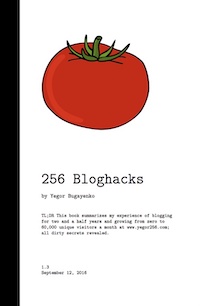Book Notes – 256 Bloghacks
A book by Yegor Bugayenko.
An interesting take on the mechanics of growing a 60k visitors-per-month blog from scratch.
Pairs well with the more abstract ideas in Show Your Work!.

Chapter 1: Attitude
Be someone and then write about it.
Entertain readers, but be yourself.
Don’t blog for money directly – ads, paid posts, etc – that’ll come indirectly later. No one wants to read a sales brochure.
Always cite sources.
Chapter 2: Content
Don’t blog about everything – only what you do.
Provoke discourse. Write to ask questions. Write to answer questions. Help the reader learn.
Don’t repeat what others have said; quote and embellish.
You can never be wrong.
Use a single main image and/or pull quotes to help understanding and prevent the page looking boring.
Bold for attention. Italics for meaning.
5-line paragraphs at the most.
Chapter 3: Community
Your core community will be small (~200 readers) – be loyal to them.
Allow comments (provoke discourse) – stay on the blog, rather than getting too involved in off-site forums.
Building a community is not just collecting email addresses.
The blog is a public communication channel.
Promote posts everywhere, but keep it constructive.
Chapter 4: Routine
Just writing is not enough; you need systematic promotion over a long period of time.
Spend ~30 minutes per week community building and promoting your posts.
Get involved in discussions on other sites and blogs (provoke discourse), but post excerpts to bring people back to your blog.
Use your blog posts as source material for tweets – remind people of your ideas.
Chapter 6: Social
Be everywhere.
Have a consistent brand – same avatar, username, etc.
If my name is “Jazz Radio” and I start playing “Metallica”…
You are a product – deliver what your users expect.
My job is to keep my radio in air, no matter how many or how few people are listening at the moment
Be consistent – keep producing content.
Aim for a high follow to followers ratio.
Don’t retweet – quote and embellish.
Chapter 7: Technical
Keep it simple; keep it static.
Use SEO tools.
Add a site search.
Provide an RSS feed and monitor Feedly stats.
Remove “decoration” on mobile – hide pull quotes. Also use a more condensed monospace font.
Make it printer friendly – add a source URL.
Validate W3C.
Check for dead links.
Show post dates on homepage – shows flow.
Promote related posts
Chapter 8: Google
Google dominates the search market so you have to know how to deal with them.
Take Google Webmasters seriously. Check it regularly.
Understand abstract and long tail keywords that bring traffic.
Page <title> and <meta> description tags matter.
Use Google autocomplete to find keywords.
Use schema.org markup.
Chapter 9: Money
Blogging costs money; ~8 hours per week.
Shouldn’t treat it as a direct source of income. The benefits are indirect:
- It’s your sales agent
- It’s a source of inspiration – a new way of looking at your skills and interests
- It gives you credebility